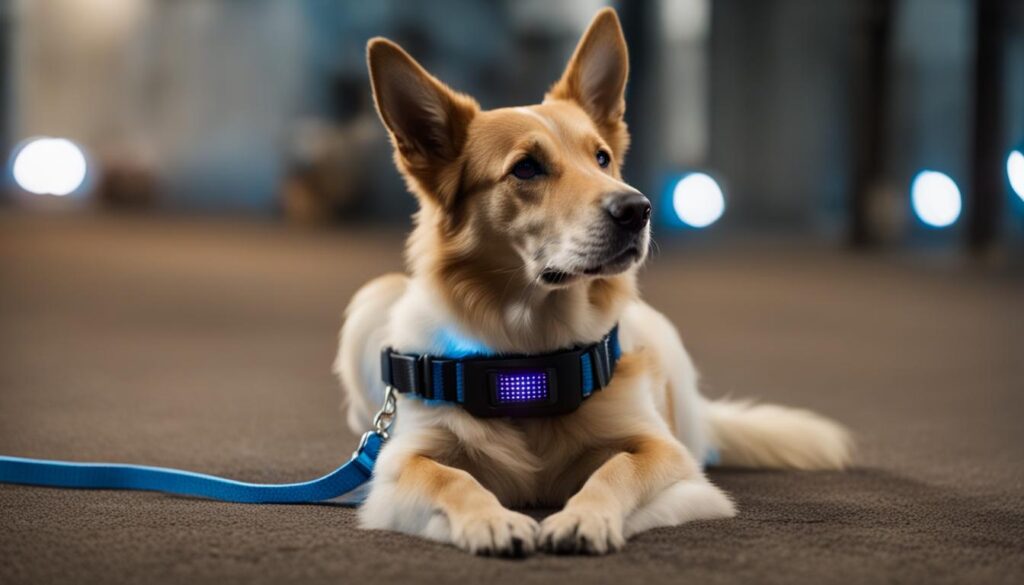Welcome to Handcraft Collars, where we offer top-quality dog training collars to help you achieve obedience and effective communication with your furry friend. Our Snap-Around Training Collar, also known as the “Volhard” training collar, is a professional’s choice for precise control and successful teaching. With our range of products and the guidance of renowned trainers, you can transform your dog’s behavior and build a strong bond. Shop today and embark on the journey towards a well-behaved and happy dog.
- Why Choose a Dog Training Collar?
- Training Aggressive Dogs with a Dog Training Collar
- Additional Features of Dog Training Collars
- Dog Training Collars with Remote: A DIY Approach to Training Your Dog
- Success Stories with Dog Training Collars
- Proper Use and Considerations of Dog Training Collars
- Training Tips and Techniques with Dog Training Collars
- The Benefits of Using a Dog Training Collar
- Conclusion
- FAQ
- Source Links
Key Takeaways:
- Our Snap-Around Training Collar offers precise control and effective teaching.
- Professional trainers recommend and use our training products.
- We also provide a 6-foot tubular nylon lead and a Volhard Dog Training DVD for comprehensive training.
- Using a dog training collar under professional guidance can address behavior issues and foster obedience.
- Shop today and start your journey towards a well-behaved and obedient dog.
Why Choose a Dog Training Collar?
A dog training collar, such as the Snap-Around Training Collar by Handcraft Collars, is a valuable tool for obedience training. It allows for precise control and effective teaching, making it the preferred choice of professional trainers. The remote feature of certain collars allows for off-leash training and the ability to correct behaviors from a distance. The use of a mild shock can be an effective deterrent for unwanted behaviors and helps to redirect a dog’s attention. It is important to use a dog training collar responsibly and under the guidance of a professional trainer.
Benefits of a Dog Training Collar:
- Precise control: A dog training collar enables you to have full control over your dog’s behavior, allowing for more effective training sessions.
- Off-leash training: With a remote dog training collar, you can train your dog even when they are off-leash, providing them with more freedom while still maintaining control.
- Behavior correction: The mild shock provided by a dog training collar can be used to correct unwanted behaviors and redirect your dog’s attention to more desirable actions.
“Using a dog training collar can offer several benefits. It provides a means of precise control and redirection of behaviors, making training more effective. When used responsibly and under the guidance of a professional trainer, dog training collars can help create a strong bond and mutual understanding between dogs and their owners.” – Professional Dog Trainer
Choosing the Best Dog Training Collar
| Collar Type | Features | Price Range |
|---|---|---|
| Shock Collar | Remote control, multiple levels of stimulation, waterproof | $40 – $200 |
| Vibration Collar | Remote control, vibration modes, adjustable intensity | $30 – $100 |
| Ultrasonic Collar | Emits high-pitched sound to deter unwanted behaviors | $20 – $80 |
When choosing a dog training collar, consider the specific needs of your dog and the training goals you want to achieve. It’s important to select a collar that is suitable for your dog’s size, temperament, and training requirements. Additionally, make sure to read and follow the manufacturer’s instructions for safe and effective use of the collar.
Training Aggressive Dogs with a Dog Training Collar
When it comes to training aggressive dogs, a dog training collar can be a valuable tool in redirecting their attention and rehabilitating their behavior. Remote collars, also known as electronic dog training collars, can provide precise control and help address aggression issues effectively. However, it is important to note that using a dog training collar for aggression should be done under the guidance of a professional trainer, as proper training techniques and timing are crucial.
Before introducing the collar, it is essential to establish a foundation of obedience training. This ensures that your dog understands basic commands and responds to them reliably. Once this foundation is in place, the collar can be used to prompt and enforce obedience commands in situations that trigger aggressive responses.
The goal of using a dog training collar for aggression is to redirect the dog’s attention away from the trigger and back to the handler. By doing so, the collar helps in breaking the cycle of aggression and teaching the dog more appropriate behaviors. Working with a professional trainer will ensure that you use the collar correctly and effectively to address your dog’s aggression issues.
Benefits of Using a Dog Training Collar for Aggression:
- Provides precise control and redirection of aggressive behaviors
- Helps in rehabilitating aggression issues
- Can be used in conjunction with obedience training for more effective results
- Allows for remote control, offering the ability to address aggression from a distance
Important Considerations:
While using a dog training collar for aggression can be beneficial, it is crucial to keep the following considerations in mind:
- Seek professional guidance to ensure proper use and timing of corrections
- Always establish a foundation of obedience training before introducing the collar
- Choose an appropriate collar size and level of correction for your dog’s temperament
- Never use the collar to cause harm or distress to your dog
By working with a professional trainer and using a dog training collar responsibly, you can help your aggressive dog overcome their behavior issues and develop a more positive and obedient mindset.
Table: Comparison of Dog Training Collars for Aggression
| Collar | Features | Price |
|---|---|---|
| Snap-Around Training Collar | Remote control, adjustable levels of correction | $99.99 |
| Electronic Training Collar | Waterproof, long-range remote control | $149.99 |
| Shock-Free Training Collar | Vibration and sound cues, gentle training approach | $79.99 |

Additional Features of Dog Training Collars
Aside from their primary role in obedience training and addressing behavior issues, dog training collars offer several additional features that make them versatile and practical tools for dog owners. These features include:
- Bark Collar for Dogs: Some dog training collars are specifically designed to control excessive barking. These collars emit a gentle correction when the dog barks, helping to discourage the behavior and promote quieter, more peaceful surroundings.
- Dog Training Collars with GPS: GPS-enabled dog training collars come with tracking capabilities, allowing you to locate your dog if they wander off or get lost. This feature provides peace of mind and ensures the safety of your furry companion.
- Waterproof Dog Training Collar: Waterproof collars are designed to withstand outdoor use and can be used in various weather conditions. Whether you’re training your dog in the rain or near bodies of water, a waterproof collar ensures durability and functionality.
These additional features enhance the functionality of dog training collars, catering to different training needs and environments. Depending on your requirements and your dog’s behavior, you can choose a collar that best suits your specific needs.
Let’s take a closer look at a table summarizing these additional features:
| Additional Features | Description |
|---|---|
| Bark Collar for Dogs | Controls excessive barking with gentle corrections |
| Dog Training Collars with GPS | Allows for easy tracking and location of your dog |
| Waterproof Dog Training Collar | Designed to withstand outdoor use and various weather conditions |
As you can see, these features provide additional functionalities that cater to specific training needs, making dog training collars even more valuable tools for dog owners.
Dog Training Collars with Remote: A DIY Approach to Training Your Dog
When it comes to training your dog, having a dog training collar with a remote can give you the control you need, even when your dog is off-leash. With the right guidance and resources, you can take a DIY approach to training your furry friend and achieve great results.
One of the advantages of using a dog training collar with a remote is the ability to give commands and corrections remotely. This means you can teach your dog from a distance, reinforcing behaviors and redirecting their attention when needed. It’s a convenient and effective way to train your dog and address behavior issues.
| Benefits of a Dog Training Collar with Remote | Why Choose a DIY Approach |
|---|---|
| You have control even when your dog is off-leash | You can train your dog at your own pace |
| It allows for precise commands and corrections | You can address specific behavior issues |
| Remotely redirect your dog’s attention | No need for expensive private training sessions |
When taking a DIY approach to training your dog with a training collar, it’s important to have access to proper guidance and resources. Online courses like those offered by DIYK9 can provide you with step-by-step instructions, training techniques, and support from experienced trainers. This can be a cost-effective alternative to private training sessions while still achieving the desired results.
Remember, consistency, patience, and clear communication are key when training your dog with a training collar. With the right tools and knowledge, you can build a strong bond with your furry friend and enjoy the benefits of a well-trained and obedient dog.
Success Stories with Dog Training Collars
Using the best dog training collar or a remote dog training collar has led to numerous success stories in dog training. Dog owners have seen remarkable transformations in their pets’ behavior and achieved impressive results. Here are some inspiring examples:
| Success Story | Training Goal | Outcome |
|---|---|---|
| Milo | Pulling on the leash | Milo’s owner used a remote dog training collar to reinforce the “heel” command. With consistent training, Milo learned to walk politely on a leash, eliminating the pulling behavior. |
| Luna | Aggression towards other dogs | Luna’s owner worked with a professional trainer and used a dog training collar to redirect Luna’s attention when encountering other dogs. Over time, Luna became more tolerant and now socializes well with other dogs. |
| Rex | Excessive barking | Rex’s owner used a bark collar for dogs to discourage excessive barking. The collar emitted a gentle correction whenever Rex barked excessively, helping him learn to control his barking behavior. |
These success stories demonstrate the effectiveness of using dog training collars in addressing various behavior issues. Whether it’s leash pulling, aggression, or excessive barking, the use of a remote dog training collar has played a significant role in shaping desirable behaviors.
“Using a dog training collar has changed the way I communicate with my dog. It has allowed me to offer immediate feedback and redirect unwanted behaviors, resulting in a happier and more obedient companion.” – Jessica, dog owner
It is important to note that the success achieved with dog training collars is often a result of responsible use and proper guidance from professional trainers. Understanding the correct timing and level of correction, along with positive reinforcement, is crucial for effective training.

The success stories and positive experiences shared by dog owners highlight the benefits of using a dog training collar. These training tools offer precise control, effective redirection of behaviors, and the ability to address various behavior issues. When used responsibly and under professional guidance, a dog training collar can be a valuable tool in building a strong bond and creating a well-behaved and obedient dog.
Proper Use and Considerations of Dog Training Collars
When using a dog training collar, it is crucial to follow proper guidelines to ensure the safety and effectiveness of the training. Here are some important considerations to keep in mind:
Proper Fit and Comfort
First and foremost, it is essential to ensure that the dog training collar is properly fitted to your dog’s neck. A collar that is too loose may not provide effective correction, while a collar that is too tight can cause discomfort or injury. It is recommended to consult the manufacturer’s guidelines or seek professional advice to determine the correct fit for your dog.
Appropriate Correction Levels
Each dog has a unique temperament and sensitivity level. It is important to choose a dog training collar with adjustable correction levels to match your dog’s needs. Start with the lowest effective level and gradually increase if necessary. Always use the mildest correction level that achieves the desired response and never use a level that causes distress or harm to your dog.
Professional Guidance
If you are considering using a dog training collar, especially for addressing aggression or behavior issues, it is highly recommended to seek professional guidance. An experienced trainer can provide valuable insight into the appropriate use of the collar, training techniques, and the correct timing of corrections. Professional guidance ensures that you are using the collar in a responsible and effective manner.
Timing and Consistency
Timing is crucial when using a dog training collar. Corrections should be given at the exact moment the unwanted behavior occurs, followed by praise or rewards when the desired behavior is exhibited. Consistency is also key, as dogs thrive on clear and predictable communication. Establishing a consistent training routine and using the collar consistently will help your dog understand what is expected of them.
By following these proper use and considerations of dog training collars, you can ensure safe and effective training for your dog. Remember to always prioritize your dog’s well-being and seek professional guidance when needed. With the right approach, a dog training collar can be a valuable tool in achieving obedience and behavior modification.
Training Tips and Techniques with Dog Training Collars
When using a dog training collar, it is important to follow proper training techniques to ensure success. Here are some tips and techniques to help you effectively train your dog:
1. Start with a foundation of obedience training
Before introducing the dog training collar, establish basic obedience commands such as sit, stay, and come. This provides a strong foundation for further training and helps your dog understand and respond to commands.
2. Gradually introduce the dog training collar
Start by using the dog training collar in low-distraction environments, such as your backyard or a quiet park. Gradually increase the level of distraction as your dog becomes more comfortable and responsive to the collar.
3. Use the collar to prompt and enforce obedience commands
When using the dog training collar, use it as a prompt to cue your dog to perform a specific command. For example, if you want your dog to sit, you can use a gentle stimulation from the collar to prompt them to sit. Pair these prompts with commands and reward your dog with praise or treats when they respond correctly.
4. Redirect your dog’s attention when necessary
If your dog gets distracted or starts exhibiting unwanted behavior, use the dog training collar to redirect their attention back to you. For example, if your dog starts pulling on the leash during a walk, a gentle stimulation from the collar can remind them to walk politely by your side.
Remember, consistency, patience, and clear communication are key to successful training with a dog training collar. By following these tips and techniques, you can effectively train your dog and strengthen your bond with them.
The Benefits of Using a Dog Training Collar
When it comes to training your dog, using a dog training collar can offer several benefits. Whether you’re looking to teach basic obedience commands or address behavior issues, these collars provide a means of precise control and redirection of behaviors, making training more effective.
One of the key advantages of a dog training collar is the ability to have off-leash control. With a remote dog training collar, you can give commands and correct behaviors from a distance, allowing your dog to roam freely while maintaining your control. This is particularly useful for outdoor activities or areas where leashes may not be practical, such as hiking or playing in a large open space.
Another benefit of using a dog training collar is its versatility. These collars are designed to address a wide range of behavior issues, from excessive barking to aggression. By using a mild shock or vibration, the collar can serve as a deterrent for unwanted behaviors and redirect your dog’s attention. It’s important to note that the shock should always be used responsibly and under the guidance of a professional trainer.
Using a dog training collar can help create a well-behaved and obedient dog, strengthening the bond between you and your furry companion. With the right training techniques and consistency, you can achieve desired behaviors and enhance your relationship. Explore the options available and choose the best dog training collar that suits your training goals and your dog’s needs.
Table: Features of Different Dog Training Collars
| Collar Type | Features |
|---|---|
| Remote Dog Training Collar | – Provides off-leash control |
| Dog Shock Collar | – Offers precise control with mild shock or vibration |
| Bark Collar for Dogs | – Controls excessive barking with gentle correction |
| Dog Training Collars with GPS | – Helps locate your dog if they wander off |
| Waterproof Dog Training Collar | – Designed for outdoor use in various weather conditions |
As you can see, different types of dog training collars offer various features to suit your specific training needs. Consider the behavior issues you want to address and choose a collar that aligns with your training goals.
Conclusion
In conclusion, dog training collars are essential tools for achieving obedience and addressing behavior issues in dogs. With their precise control and redirection capabilities, these collars offer an effective means of training your furry companion.
Whether you’re looking for the best dog training collar, a remote dog training collar, or a dog shock collar, there are various options available to suit your specific needs. The e-collar for dog training provides off-leash control and the ability to correct behaviors from a distance, while the dog training collar with a remote allows you to give commands remotely.
Additionally, dog training collars come with other useful features, such as bark collars for dogs to control excessive barking, GPS tracking capabilities to locate your dog if they wander off, and waterproof designs for all-weather use.
Remember, responsible use of a dog training collar is crucial. Seek professional guidance, especially when addressing aggression or behavior issues. Follow proper training techniques, ensuring the collar is properly fitted, and using appropriate correction levels. With consistency and patience, you can build a strong bond and a well-behaved dog using a dog training collar.
FAQ
What is a dog training collar?
A dog training collar is a tool used for obedience training and behavior correction in dogs. It allows for precise control and redirection of behaviors during training sessions.
How does a dog training collar work?
A dog training collar typically uses remote-controlled static stimulation or vibration to prompt and enforce obedience commands. The collar is used as a tool to redirect a dog’s attention and discourage unwanted behaviors.
Are dog training collars safe for dogs?
When used responsibly and under the guidance of a professional trainer, dog training collars are safe for dogs. It is important to follow proper training techniques and ensure the collar is fitted correctly to avoid discomfort or injury.
Can I use a dog training collar on a puppy?
It is generally recommended to wait until a puppy is at least six months old before using a dog training collar. Puppies require a foundation of basic obedience training before introducing the collar.
How do I choose the right dog training collar for my dog?
The right dog training collar will depend on your dog’s size, temperament, and individual training needs. It is recommended to consult with a professional trainer who can guide you in selecting the most suitable collar for your dog.
Can I use a dog training collar for aggression issues?
Dog training collars can be used as part of a training program for aggression issues. However, it is important to work with a professional trainer to establish a foundation of obedience training and to ensure the collar is used responsibly and effectively.
How long does it take to see results with a dog training collar?
The time it takes to see results with a dog training collar will vary depending on the dog and the training techniques used. Consistency, patience, and clear communication are key to achieving desired behaviors.
Can I use a dog training collar for other behavior issues, such as excessive barking?
Yes, there are dog training collars specifically designed to address excessive barking. These collars emit a gentle correction when the dog barks, helping to discourage the behavior.
Are there any additional features available with dog training collars?
Yes, dog training collars can come with additional features such as GPS tracking capabilities for locating your dog if they wander off. There are also waterproof collars designed for outdoor use in various weather conditions.
Can I train my dog myself with a dog training collar?
Yes, dog training collars with a remote allow dog owners to train their dogs themselves. However, it is important to educate yourself on proper training techniques and seek guidance from resources such as online courses or professional trainers.
What are the benefits of using a dog training collar?
The benefits of using a dog training collar include precise control and redirection of behaviors, off-leash training capabilities, and the ability to address a wide range of behavior issues. When used responsibly, dog training collars can help create a well-behaved and obedient dog.




